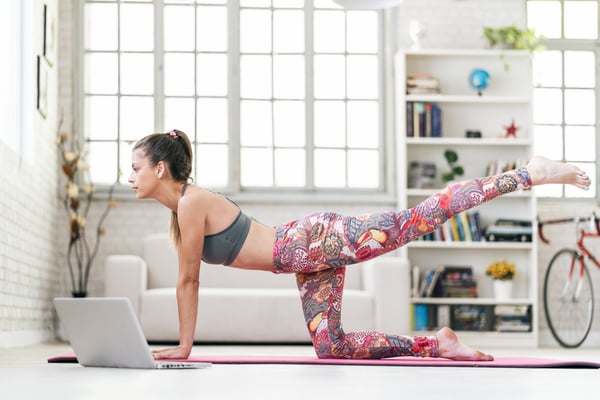
Offering remote yoga classes has been an idea I have thought about for a while due to the value it could bring to my business. For instance, offering online courses could help me market and reach students who cannot take my current in-person courses, increase the number of people I can help, and cultivate more revenue for my business.
Due to the COVID-19 pandemic, many yoga and fitness instructors have been adapting their classes to an online form. This includes but is not limited to Zoom, Instagram TV, Facebook Live, and YouTube.
If anyone had told me a few weeks ago that I would be teaching all of my fitness and yoga classes online, I would not have believed them. Like many of us, I have had to adjust course and learn online class best practices to successfully adapt to this remote time-period.
Regardless of the technology selected, the tips listed below will help prepare those of you transitioning to teaching yoga live online, or recording a home yoga video.
Tips for the Transition to Online Yoga Classes:
Commit to the technology: It is essential to pick one technology to start with initially. Once it is selected, inform your participants about the logistics. Participants need to know where to go to take your classes and connect with what you are offering. They also need to know what they need technology-wise to participate.
For example, if you utilize Zoom, participants need to create a free profile first before they can access your zoom room, and download it to their device. Once your technology is selected, stay consistent with that technology. Regardless if you are committing to a 1:00 p.m. timeslot on Facebook Live, or focusing just on pre-recorded YouTube videos, pick and commit so that there is class consistency.
Select an appropriate home environment:
Selecting a suitable home environment is essential for a successful online yoga class. Make sure that the environment or background chosen is simple and clean. Less is more so that participants, or yourself, do not get distracted in the middle of class. I recommend moving distracting items out of the way in your home as best you can for a clear video for participants.
Part of the selection process is asking yourself the following questions:
- Where in your home could the background be clean and straightforward?
- Where in your home has the best lighting?
- Where will there be the least amount of noise or distractions? (The answer to this question might determine the best time of day to offer a class as well)
- Where in your home do you have the most space to move?
Keep in Mind Best Practices –
The best practices for teaching an online yoga class are the same factors we keep in mind every time we teach. For example, these best practices include introductions, disclaimers, modifications, and proper cueing techniques.
Introductions:
It is essential to introduce yourself at the start of each online class. Due to the accessibility of an online course, it is possible that there is something taking the class you do not know, and is experiencing your class for the first time. These individuals need to get the same experience they would get in-person at a studio.
Disclaimers/Modifications:
It is essential to provide a disclaimer if any pose or movement you are teaching has contraindications, or is not appropriate for a specific condition (i.e., pregnancy, high blood pressure, etc.). If that is the case, offer modifications and choice within the class sequence itself.
Cueing Technique:
Make sure that you are incorporating the same valuable cueing that you would provide students in an in-person class. One way to do this successfully is to write down what you plan to say during the preparation stage and rehearse so that you do not forget once cameras are rolling. This can make anyone nervous if they are new to it, so rehearsing is essential.
While providing your class cues, remember best practices with cueing techniques. For example, speak loud enough so that students can hear you, talk clearly, be precise, and emphasize the words spoken. Last but not least, be mindful of non-verbal communication and body language. This can make or break an online class.
Music Decisions:
Decide if you plan to use music or not for your online class. It is important to note that there is no right or wrong choice here. Consider the following questions if you are considering whether or not using music is the right choice:
- Is using music best suited for your yoga class format?
- Is music preferred by your regular students?
- Do you prefer to teach with music?
- Will your students be willing to try a class without music?
If utilizing music is best for your class, prep your playlist before class like you usually do. However, the added step is making sure that the music can be heard while utilizing your chosen technology.
For example, if you are using Zoom to teach your remote classes, and plan to include music, test this out with a friend first. Make sure to understand all technical logistics so that there are no issues once live to students. The last thing anyone would want is for students not to be able to hear you teach during an online offering.
Concluding Thoughts: Embrace the Change!
Overall, during this time of transition, it is essential to get comfortable with the uncomfortable. Consider teaching live or recorded online classes as a new learning and growth opportunity. This will create the optimal mindset to keep learning along the way. It will also expand your reach, so you can teach more people the many reasons why you should teach yoga.
If you want to access to a free mini-course about how to get started teaching virtual group fitness classes, just follow the link!
For some ideas on how to best connect and provide excellent service to your clients right now, click here for a fitness guide during COVID-19. Although the scope of that article mostly dwells on personal training - and not group fitness specifically - there are still some helpful tips throughout.
*One thing to note is that this article does not discuss the liability concerns of teaching an online class. If you are teaching a class for a yoga studio or facility, talk about liability insurance with your studio or facility owner, and make sure you are covered. If you are teaching as part of your own business, make sure that all participants have the appropriate waivers filled out, and you have your liability insurance.

